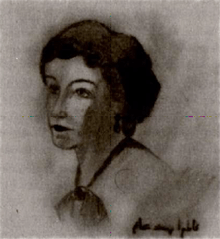Pesend Hanım
| Pesend Hanım | |
|---|---|
 | |
| Born |
Fatma Kadriye 13 February 1876 Istanbul, Ottoman Empire |
| Died |
5 November 1924 (aged 48) Istanbul, Turkey |
| Burial | Karacaahmet Cemetery, Üsküdar, Istanbul |
| Spouse | Abdul Hamid II |
| Issue | Hatice Sultan |
| Father | Sami Achba |
| Mother | Fatıma Mamleeva |
| Religion | Sunni Islam |
Pesend Hanım (Ottoman Turkish: پسند خانم; born Fatma Kadriye Achba; 13 February 1876 – 5 November 1924) was the eleventh wife of Sultan Abdul Hamid II of the Ottoman Empire.
Early life
Pesend Hanım was born on 13 February 1876 in Achba Mansion, Horhor, Istanbul. Born as Fatma Kadriye Achba, she was a member of Abkhazian princely family Anchabadze. Her father was Prince Ahmed Sami Bey (1839 – 1915),[1] the son of Prince Ahmed Bey and Patıma Hanım Eşba.[2] Her mother was Princess Fatıma Hanım Mamleeva (1844 – 1923), the daughter of Tatar prince Ismail Bey Mamleeva.[1] She had an elder sister Ayşe Mahizer Hanım (1871 – 1948), and a younger brother Prince Şükrü Bey (1878 – 1940).[2]
Fatma's father was in service to Sultan Abdülaziz's eldest son Şehzade Yusuf Izzeddin, and later to Abdul Hamid's eldest son Şehzade Mehmed Selim.[3]
Fatma was a painter by avocation.[4] She also had learned French, and Italian. She had a penchant for horse riding and, did riding on the family's Arabian horses. She had a broad knowledge of culture, and loved to read books.[1]
Marriage
One day Abdul Hamid happened to see Fatma, when the latter came along with her mother and elder sister to Yıldız Palace on an invitation of Prince Selim's mother, Bedrifelek Kadın. Abdul Hamid acquired about her, and came to know about her from his son Selim.[5]
Abdul Hamid asked her hand in marriage from her father. He concented to Abdul Hamid's proposal, and the marriage took place on 20 July 1886 at the Yıldız Palace.[5] She was given the name "Pesend",[6] and the title of "Dördüncü Ikbal".[7] On 10 June 1887, a year after the marriage, she gave birth to her only child, Hatice Sultan, who lived only eight months.[8]
Hatice's early death in 1898 prompted Abdul Hamid to order the construction of a modern hospital in Istanbul exclusively for the treatment of children and pregnant women.[9] The construction of the hospital started on 12 May 1898 and completed on 5 June 1899. It was called "Hamidiye Etfal Hastahane-i Âlisi", and was completely Abdul Hamid's creation and totally under his supervision.[10]
Hamide Ayşe Sultan, her step daughter, notes in her memoirs that whenever Dilber Cenan Hanım, Abdul Hamid's wetnurse, visited the palace, she would stay as a guest in Pesend's household.[11]
In 1909, she was given the title of "Üçüncü Ikbal".[7] On 27 April 1909, Abdul Hamid was deposed, and sent into exile in Salonica.[12] Pesend was closed to Abdul Hamid, and accompanied him for some time,[4] and returned to Istanbul in 1910.[7] After Salonica fell to Greece in 1912, Abdul Hamid also returned to Istanbul, and settled in the Beylerbeyi Palace, where he died in 1918.[13]
Death
Pesend died in her villa at Vaniköy,[4] on 5 November 1924,[2][14] and was buried at Karacaahmet Cemetery at Üsküdar.[7]
In popular culture
In the 2017 TV series Payitaht: Abdülhamid, Pesend Hanım is portrayed by Turkish actress Zeynep Özder.[15]
See also
References
- 1 2 3 Açba 2007, p. 148.
- 1 2 3 Açba 2007, p. 150.
- ↑ Açba 2004, p. 30.
- 1 2 3 Brookes 2010, p. 281.
- 1 2 Açba 2004, p. 31.
- ↑ Açba 2007, p. 149.
- 1 2 3 4 Uluçay 2011, p. 250.
- ↑ Uluçay 2011, p. 258-9.
- ↑ International Journal of Turkish Studies, Volume 13. University of Wisconsin. 2007. p. 180.
- ↑ New Perspectives on Turkey, Issues 20-23. Simon's Rock of Bard College. 1999. p. 18.
- ↑ Brookes 2010, p. 136.
- ↑ Hall, Richard C. (October 9, 2014). War in the Balkans: An Encyclopedic History from the Fall of the Ottoman Empire to the Breakup of Yugoslavia. ABC-CLIO. pp. 1–2. ISBN 978-1-610-69031-7.
- ↑ Parry, Milman; Lord, Albert B. (1979). Serbocroation heroic songs, Volume 1. Harvard University Press. p. 371.
- ↑ Açba 2004, p. 32.
- ↑ Payitaht: Abdülhamid (TV Series 2017– ), retrieved 2018-09-22
Sources
- Uluçay, M. Çağatay (2011). Padişahların kadınları ve kızları. Ötüken. ISBN 978-9-754-37840-5.
- Açba, Harun (2007). Kadın efendiler: 1839-1924. Profil. ISBN 978-9-759-96109-1.
- Açba, Leyla (2004). Bir Çerkes prensesinin harem hatıraları. L & M. ISBN 978-9-756-49131-7.
- The Concubine, the Princess, and the Teacher: Voices from the Ottoman Harem. University of Texas Press. 2010. ISBN 978-0-292-78335-5.
- Sakaoğlu, Necdet (2008). Bu Mülkün Kadın Sultanları: Vâlide Sultanlar, Hâtunlar, Hasekiler, Kandınefendiler, Sultanefendiler. Oğlak Yayıncılık. ISBN 978-6-051-71079-2.
Further reading
- Osmanoğlu, Ayşe (2000). Babam Sultan Abdülhamid. Mona Kitap Yayinlari. ISBN 978-6-050-81202-2.
_p259_Sultan_Abdul_Hamid_II.jpg)
